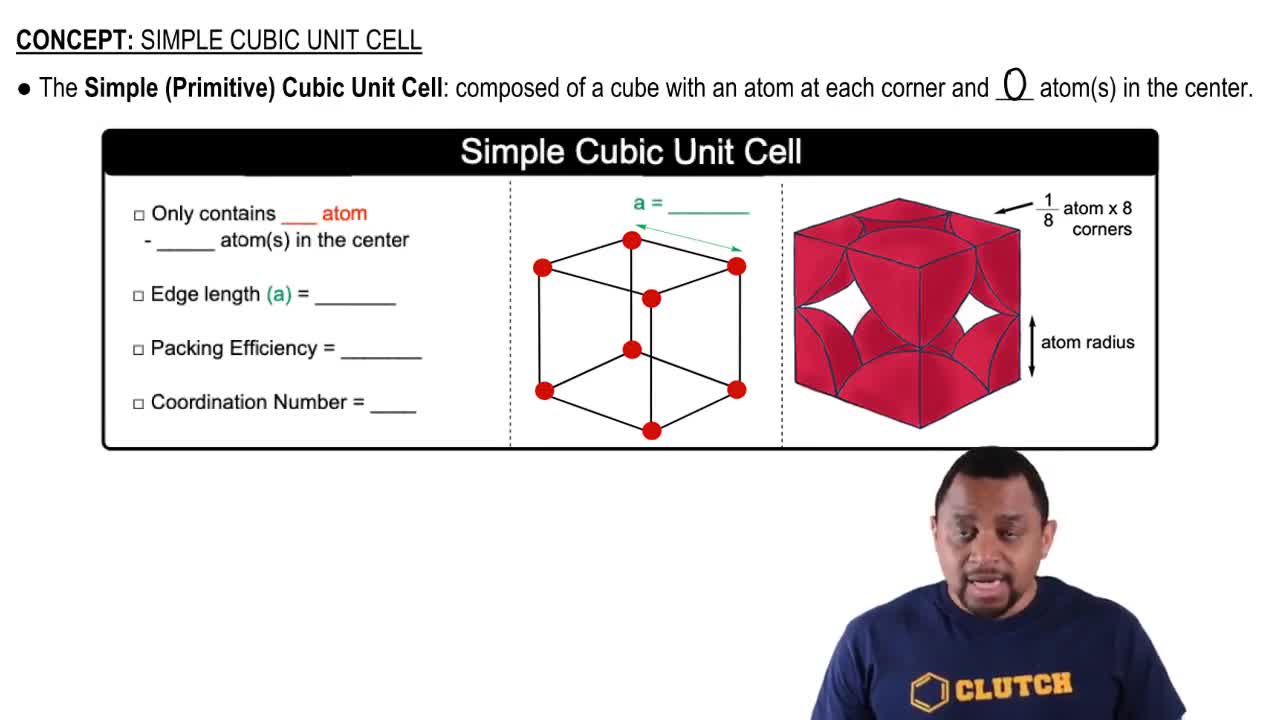Indicate the type of solid (molecular, metallic, ionic, or covalent-network) for each compound: (c) Ta2O5 (melting point, 1872°C)
Ch.12 - Solids and Modern Materials
Chapter 12, Problem 19a
(a) Draw a picture that represents a crystalline solid at the atomic level.
 Verified step by step guidance
Verified step by step guidance1
Step 1: Understand that a crystalline solid is a material whose constituents, such as atoms, molecules, or ions, are arranged in a highly ordered microscopic structure, forming a crystal lattice that extends in all directions.
Step 2: Visualize the crystal lattice as a repeating pattern of unit cells, which are the smallest repeating units that make up the crystal structure.
Step 3: Consider a simple cubic lattice, where atoms are located at each corner of a cube. This is one of the simplest types of crystal lattices.
Step 4: Imagine each atom as a sphere, and in a simple cubic lattice, these spheres are arranged in a grid-like pattern, with each sphere touching its neighbors along the edges of the cube.
Step 5: To draw this, sketch a cube and place a sphere at each corner, ensuring that the spheres are evenly spaced and aligned, representing the regular, repeating pattern of a crystalline solid.

Verified video answer for a similar problem:
This video solution was recommended by our tutors as helpful for the problem above.
Video duration:
36sWas this helpful?
Key Concepts
Here are the essential concepts you must grasp in order to answer the question correctly.
Crystalline Structure
A crystalline structure is a highly ordered arrangement of atoms, ions, or molecules in a solid. This regular pattern extends in three dimensions, forming a lattice that defines the solid's geometric shape. Each point in the lattice represents a position occupied by an atom or a group of atoms, contributing to the solid's stability and unique properties.
Recommended video:
Guided course

Crystalline Solids Structure
Unit Cell
The unit cell is the smallest repeating unit of a crystalline structure that, when stacked together, forms the entire crystal lattice. It contains all the essential information about the arrangement of atoms and their positions. Understanding the unit cell is crucial for visualizing and drawing the overall structure of a crystalline solid.
Recommended video:
Guided course

Simple Cubic Unit Cell
Atomic Bonding
Atomic bonding refers to the forces that hold atoms together in a solid. In crystalline solids, these bonds can be ionic, covalent, or metallic, depending on the nature of the atoms involved. The type of bonding influences the properties of the solid, such as its melting point, hardness, and electrical conductivity, which are essential to consider when representing the structure at the atomic level.
Recommended video:
Guided course

Atom Structure
Related Practice
Textbook Question
1258
views
Textbook Question
You are given a gray substance that melts at 700 °C; the solid is a conductor of electricity and is insoluble in water. Which type of solid (molecular, metallic, covalent-network, or ionic) might this substance be?
500
views
Open Question
You are given a white substance that melts at 100 °C. The substance is soluble in water. Neither the solid nor the solution is a conductor of electricity. Which type of solid (molecular, metallic, covalent-network, or ionic) might this substance be?
Textbook Question
(b) Now draw a picture that represents an amorphous solid at the atomic level.
685
views
Textbook Question
Two patterns of packing for two different circles of the same size are shown here. For each structure (b) determine the angle between the lattice vectors, g, and determine whether the lattice vectors are of the same length or of different lengths; (i)
(ii)
444
views
Textbook Question
Two patterns of packing two different circles of the same size are shown here. For each structure (c) determine the type of two-dimensional lattice (from Figure 12.4). (i)
(ii)
407
views
